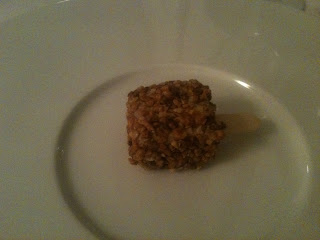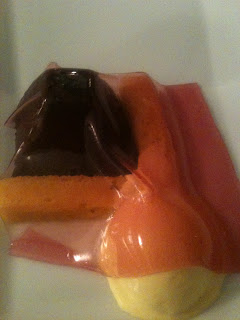“This dish,” Massimo Bottura, chef proprietor of the World’s 4th Best Restaurant*, modestly tells us, “moves from Robuchon at the bottom to Ferran Adria at the top, with my grandmother in between.” What nonna Bottura makes of that particular arrangement is, as far as I know, unrecorded, but it’s certainly the most pretentious thing I’ve heard in a restaurant.
The dish in question is one of the better efforts in our €130 ‘Classics’ tasting menu (a ‘Sensations’ menu would have cost €170, the ‘Traditional’ €100, and a la carte about €45 per dish). It’s a ‘compression of pasta and beans’ that features a wildly rich piece of foie gras at the bottom (the Robuchon, presumably), hints of pasta, parmesan and balsamic in the middle (granny), a bean broth/puree type thing above (ditto), and a kind of foam that tastes of rosemary on top (Adria). “We suggest you put your spoon right to the bottom to have all the sections at once,” says one of our waiters. We try, we really do, but it’s pretty difficult, and we end up slurping half-formed bits of pasta and leave most of the foie gras until the end by accident. As a whole, it doesn’t work at all, but its discrete parts are all wonderful in their ways, so we enjoy it.
This dish, like many at Osteria Francescana, seems designed to challenge diners, to try their patience and understanding as much as their palettes. It is, of course, very impressive to press home-cooked Italian tradition in between two of the great culinary masters of the era, very difficult to smuggle mama’s kitchen into the same shot glass as Rebuchon’s French and Adria’s extra-planetary styles. Massimo pulls it off with something approaching aplomb. But, there’s a question that no one seems to have asked: why bother? For all its allusive pyrotechnics, the dish doesn’t make sense, the flavours don’t work (or at the very least, don’t balance) and the contrast in textures resolves into something cloying and over-rich.
This dish is our fifth of nine. We started, a long time ago, with ‘a memory of Mortadella sandwich’. It sounds like it should be treading the same sort of path as Heston Blumenthal’s sardine ice-cream: that is, providing a nostalgia trip, deploying exhilarating techniques to crystallise a taste memory in a new and exciting form. A ‘memory of Mortadella sandwich’ (the English translation doesn’t help it) does not do that. It’s a strong, light Mortadella pate served with some crispy bread and pistachio. If you had it as a canape at a friend’s, you’d be extremely impressed; as the opening salvo at the best restaurant in Italy**, it’s pretty disappointing.
Next up is an ice-lolly. Or is it? No, it isn’t, actually. It’s calvados-flavoured foie gras on a stick rolled in hazlenuts, with some thick, cool, viscous balsamic vinegar inside. The waiters bring us a knife and fork, then the plate, and then one of them intones the instruction: “We suggest you eat this with your fingers”. In another restaurant, this would be played as a joke (it is, I think, quite funny). Here, it is as if they want you to eat with your fingers but also to remind you that you’re sitting in a very serious, very formal, very good restaurant. This is not a place for fun. The dish is delicious, in the way that foie gras rolled in nuts is almost certain to be. I’m not sure it’s all that innovative, but that’s another matter. It reminds us of a Feast – ‘memory of a nutty lolly’, perhaps.
This is followed by one of the highlights of the evening: a slightly sour, warm, leek, truffle and shallot tart with black truffle shaved on top. The truffle shavings are predictably flavourless (surely I can’t be the only one who thinks that shaved black truffle has a bit of the emperor’s new clothes about it), but the tart is a wonder, autumnal and enveloping and extremely tasty. It’s the first dish of the evening that feels like it could only have been made here.
Alas, next comes the Rebuchon/Adria/granny concoction, and we bump a little bit back down to earth. No matter, that’s followed by a cotechino and lentil ravioli, steamed to perfection in Lambrusco (the local tipple). It’s very good indeed, with perfect pasta encasing a luxurious but not too fatty sausage and lentil mix, the three textures playing off each other to great effect.
The kitchen feels like it’s on a roll now, and the next course promises much – bollito misto is about as traditional a dish as you can find in this part of Italy. Boiled bits of tongue, head, sometimes trotter, belly and any other odd bits of pig and cow end up here, typically served with a green, herby salsa verde and sweet salsa rossa. It’s like that here, but with a key difference: this bollito is, the waiter proudly states, "bollito non-bollito".
The meat is not boiled, it’s cooked sous vide; the salsa rossa is a sweet impression of a peperonata; the green sauce is green foam. It’s delicious, certainly, but it’s not as good as the one we have the next day for about €12 (review to follow), mainly because what you gain in texture from sous vide, you lose in stock flavour. Again, the techniques are flawless, but the dish fails to provide a satisfactory explanation of its own existence.
A pre-dessert of goats’ cheese ice cream and honey is a marvellous palate cleanser, setting us up perfectly for the main event – zuppa Inglese. This weird concoction of sponge, chocolate and boozy orange, with Alchermes liqueur, is strange enough at the best of times – like an English trifle on LSD. But here, it’s bizarre to the point of unpalatability. Looking like the kind of thing a precocious 16 year old would serve on MasterChef, there’s a delicious chocolate cake sat next to uninteresting, boozy sponge and a cold vanilla thing that hovers somewhere in texture between custard and ice-cream. This in turn is covered with a thick layer of chewy, flavourless pink gelatine that looks and tastes like cellophane. It’s ridiculous. The zuppa Inglese we order with lunch the next day is far better.
With excellent coffee and petit fours, super breadsticks and decent, plentiful bread, Osteria Francescana has the peripherals doing more or less what they should. But over-zealous water and wine waiters (note that plural – there are a lot), create a trial-like atmosphere that distracts from the food and a delicious, cool bottle of Lombardian pinot nero. The restaurant is stuffy and arty (like the food) – everyone whispers, no one smiles.
Italy is arguably the best place in the world to eat because it is blessed with the best traditions, the best ingredients and the best attitudes toward food. At Osteria Francescana, all three go out the window. For €370 for two with one bottle of wine, it’s a bit disappointing.
*may not be accurate
**may not be accurate
Phil Letts' take: 5/10










No comments:
Post a Comment